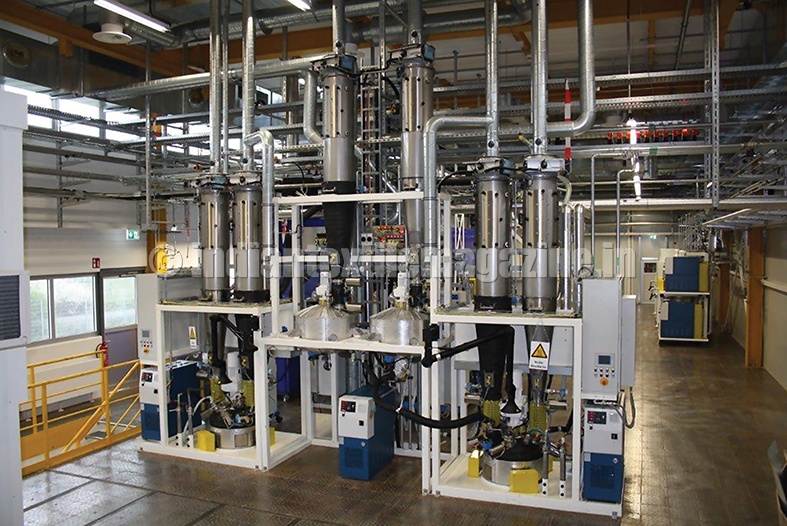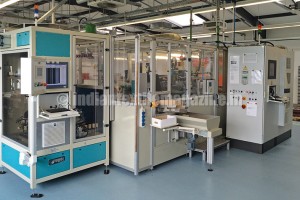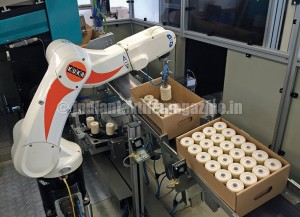
Texturing refers to the process of giving smooth synthetic fibers (filament yarns) made from polyamide, polyester or polypropylene the characteristic of natural fibers like cotton or wool. To achieve this, one of the key components is the texturing disc.
Saurer Components offers the most suitable Temco friction discs in differing thicknesses and diameters for all of the standard friction units. Its customers are able to select different levels of shore hardness and disc profiles to achieve the best overall performance.
Hard and soft material friction discs
There are two widely acknowledged types of friction disc: Hard and soft materials.
The first generation of hard material discs had surfaces with nickel-diamond coating or a ceramic plasma coating. This caused considerable problems at a practical level as the surfaces were very abrasive to the thread.
At the same time, it also became clear that the surface structure changed over time, and with it the resulting yarn characteristics.
The next step were full ceramic discs, which provided improvements to the process and created a little less abrasion to the thread.
Aluminum oxide ceramic is so wear-resistant that its surface structure hardly changes over time. The phenomenon of “glazing”, where a thin polymer film forms on the surface of the disc that hampers the process hugely remains as yet, unresolved. The glazing can only be removed with a great deal of effort, and to make things worse, the cleaned discs are always more susceptible to this problem.
Additionally, it can also cause problems when the discs make contact with metallic objects during operation. Traces of metal on the surface of the discs that are barely visible have a negative impact on the strength and stretching of the yarn and can lead to breakages in the filament.
With polyurethane friction discs, the yarn is “harder” than the surface of the disc. This means that there is almost no abrasion of the thread and that the tenacity and elongation of the textured yarns achieve appreciably higher values than they do with ceramic discs. The high friction value between the disc and the thread enables a high degree of yarn stretching and therefore bulkiness.
Factors which influence the lifespan of PUR friction discs
The wear and therefore the lifespan of the PUR friction discs are influenced by the mechanical stress due to the thread, abrasion resistance and chemical reactions with spinfinish.
The load on the PUR surface is generally process-related. Low levels of thread tension and low production speed result in a long lifespan.
Of all the elastic materials, polyurethane has the highest abrasion resistance, which is why friction discs made from rubber, for example, did not prevail on the market.

Spinfinish generally consists of three components – lubricants, emulsifiers and anti-static products. The continuous addition of extremely small quantities of spinfinish on the surface of the friction disc has two effects, namely, volume swelling and hydrolytic degradation.
Strong volume swelling leads to changes in the geometric conditions in the texturing aggregate and therefore causes changes to the yarn characteristics. In the worst case, the friction discs touch at the sides.
The hydrolytic attack begins on the so-called soft segments of the PUR, and splits the highly molecular chains into shorter fragments. As a result, the abrasion resistance decreases and the increasing changes to the disc profiles lead to the premature failure of the discs.
There is generally no link between the volume swelling and the chemical attack.
Optimization of the lifespan
Saurer Components was the first manufacturer of PUR friction discs to successfully establish itself in the field of friction texturing. The basis for this was provided not only by its in-depth knowledge of polyurethane material from the era of magnetic spindle texturing, but primarily from the intensive basic research in collaboration with Freudenberg Sealing Technologies.
At the textiles laboratory in Hammelburg, the bases for textile technology were developed on texturing aggregates that had been manufactured in-house.
Customers who wanted to use the PUR discs received exact instructions on the process optimization and direct support on-site from textile technologists.
The company offered its customers a unique service then as it still does today and check the spinfinish and assess the suitability for the use of PUR discs.

In those days, the testing methods applied by texturing companies were often insufficient. It was frequently the case that the aggressiveness of the spinfinish or the resistance of PUR was determined by the degree of swelling which often led to inaccurate results.
On the basis of the Temco testing method, the spinfinish manufacturers (the TEGEWA Association e.V.) started developing a standard test for the assessment of preparations related to PUR. As a result of this, the spinfinishes developed were increasingly more “PUR friendly”.
At the same time, on the PUR side further work was completed on increasing the wear and spinfinish resistance.
The production process was subjected to a detailed analysis in order to produce the best possible material. From the selection of raw materials to the production of the granulate and the injection molding, through to the final processing, the entire process was optimized to the best effect.
Quality assurance
Ensuring a high level of quality begins with the production of the PUR granulate.
Prior to serial production, sample discs for serial approval are manufactured from every batch of granulate.
In addition to the mechanical and chemical characteristics that ensure a long lifespan, the characteristics during texturing of both the standard and microfibers are also tested. The same tests are carried out on a randomized basis during the serial production.
The outer contour of the friction discs is ground in an automatic processing center.
After grinding, a visual check is completed of each individual disc.
This takes place using 4 line-scan cameras, during which the disc is turned and illuminated with LEDs. During the visual check the very smallest impurities, discolorations, imperfections and protrusions are discarded.
A robot places the finished products into a shipping carton.
Continuous improvements to the formula, process optimizations and comprehensive testing during the manufacturing process, all confirm Saurer Components’ leading edge over its competitors. For customers, this means that they can rely on a product of high technical standard.